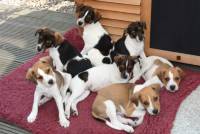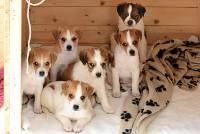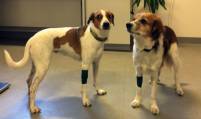A Little Excursion into Genetics
We quote again Dr. Irene Sommerfeld-Stur, here from her book "Rassehunde-Zucht - Genetik für Züchter und Halter":
"Many dog breeds are burdened with several diseases, sometimes at such a high frequency, that there are hardly any really healthy dogs available for breeding (...). It is primarily the breeders themselves who are responsible for this accumulation of diseases. Wrong Breeding strategies and ignorance or disregard of population-genetic relationships ensure that defects can spread largely unhindered in the populations. Line breeding, excessive use of individual males and wrong selection priorities are the tools that support the spread of genetically caused diseases.
The biggest problem, however, is the completely inadequate transparency with regard to the flow of information about the occurrence of diseases. Diseases in one's own line are concealed, and even diseases that occur in other breeders of the same breed are swept under the table if possible. Breeders who openly report illnesses in their kennel or in the breed are bullied and outlawed as nest polluters. This ultimately results in a very high number of unreported cases for genetic defects, which above all makes timely control difficult or impossible. In this context, hereditary defects show common features with malignant tumors. If you fight them in time and effectively, you can eliminate them. If you wait too long, they spread and become incurable. The end is the same - death, in this case the death of a race."
"Research in the field of molecular genetics in dogs has brought an enormous development in recent years that is far from over. Especially in the area of clarification or diagnosis of genetic defects and diseases, this opens up very efficient options for breeding Control. A corresponding success presupposes that the available possibilities are used and above all that they are used sensibly and taking into account the respective population situation." (Many thanks to Dr. Sommerfeld-Stur for permission to quote her on our website)
In this sense, all dogs used for breeding are subjected to a gene scan in our breeding club. The decision was made in favor of the Genoscoper laboratory in Finland (MyDogDNA), which not only looks for the gene locations of individual disease systems, but also looks at the genetic makeup of the respective dogs as a whole, naturally taking into account the breed-specific differences. The comparatively clear costs are borne by the individual breeders and stud dog owners. Likewise, for some years now all puppies born in the club have been subjected to such a genome scan. An example of such a test result can be found below.
For a better understanding, it is helpful to know that hereditary diseases are largely recessive. This means that an individual must inherit an attachment from both parents in order to develop a trait. We inherit all of our properties in one version from the father and the mother. Let us take the example of the short or long hair system for our dogs. We know that short-hairedness is inherited dominantly over long-hairedness. If we look at our A-litter, Doola (purebred long-haired) contributes two recessive systems for long-hairedness (ll) and Jarl, the stud dog (pure-bred short-haired), two dominant systems for short-hairedness (LL).
As was to be expected, all of their children are short-haired in their phenotype, i.e. in appearance. In the genotype they are equally short and long-haired, we call the result heterozygous (mixed-hereditary) short-haired (Ll), i.e. externally they are short-haired, but can pass both plants on to their offspring.
Jarl / Doola | l | l |
L | Ll | Ll |
L | Ll | Ll |
For our C-litter Liesi, mixed-hereditary short-haired (Ll), has now been mated with Fimo, pure-hereditary long-haired (ll) :
Fimo / Anneliese | L | l |
l | Ll | ll |
l | Ll | ll |
So there was a probability of 50% short or long hair. As we know, this is just a probability, in fact we had 2 long-haired and 4 short-haired C-puppies.
The same applies to the inheritance of genetic defects. Liesi wears e.g. the facility for macrothrombocytopenia, a blood clotting disorder. She herself cannot get it because she only got the system from one parent. All we had to do was make sure that her mating partner did not wear the system, because then we would have risked a 25% chance of illness in their offspring (traits). This would look like this (A stands for the attachment-free allele, a for the recessive disease allele):
A | a | |
A | AA (free) | Aa (carrier) |
a | Aa (carrier) | aa (ill) |
Without a genetic test, we could have mated two healthy dogs whose offspring would have had a 25% chance of getting sick. Since the system for macrothromocytopenia is very rare in Kromfohrländer, it was unproblematic to find a suitable mating partner without any attachment here, this also applies to "Hereditary Hyperuricosis (HUU)". This is different e.g. for "Hereditary footpads hyperkeratosis (HFH)" and especially for the "Von Willebrand syndrome (vWD type 1)", also a blood clotting disorder. We ourselves are lucky that none of our bitches inherited this plant. However, recent research fears that more than 40% of all Kromfohrländer are carriers of this syndrome. Mating without a previous genetic test can therefore be regarded as grossly negligent. Do not hesitate to ask your breeder about such tests. If you already have a dog, it is helpful to have it tested and report the result to your breeder and the appropriate breeding association. The vWD is not new, but a gene mutation (also in the Kromfohrländer) has now been linked to it, see here:
The study, which has been running since 2018 in collaboration with the Feragen gene laboratory in Austria, has now confirmed the relationship between the found genotypes and the symptoms of this disease (information HERE), thus validating the genetic test we have been using since August 2017. Doola and Liesi contributed reference samples to the study as plant-free dogs. And because we were there, we also sent blood to the TH Hanover and the University of Bern, where, among other things, studies on the subject of cystinuria are ongoing.
With MyDogDNA, besides hereditary footpads hyperkeratosis, hereditary hyperuricosis and the "von Willebrand syndrome" also the facilities for other physical characteristics (size, color, check, fur structure and length, ear shape etc.) are examined, as shown here using the example to see from Doola's genetic test:
All of these tests can help to minimize the spread of inheritable disorders, diseases and dysfunctions - IF YOU USE THESE POSSIBILITIES!
It should be noted that we cannot guarantee a healthy dog in this way, because the responsible gene mutation is not yet known for many diseases, often several are involved. But we can and will make the greatest possible contribution (not only in the sense of the Animal Welfare Act). This genetic test is a step in this direction, you can find another one under cross-breeding project
Tierschutzgesetz § 1: Zweck dieses Gesetzes ist es, aus der Verantwortung des Menschen für das Tier als Mitgeschöpf dessen Leben und Wohlbefinden zu schützen. Niemand darf einem Tier ohne vernünftigen Grund Schmerzen, Leiden oder Schäden zufügen (The purpose of this law is to protect human life and well-being out of the responsibility of humans for animals as co-creatures. Nobody is allowed to cause pain, suffering or harm to an animal for no reasonable reason).
The VDH breeding regulations include, among other things, breeding strategies and a phase program to combat hereditary diseases and defects, which we also follow, see here:





